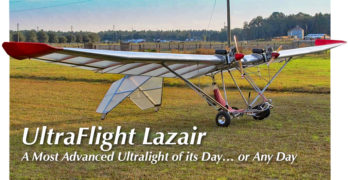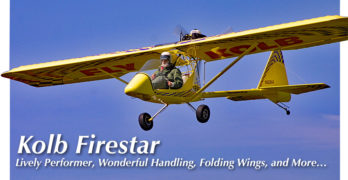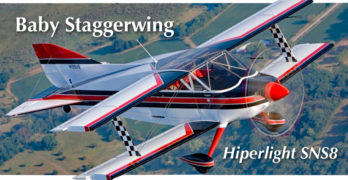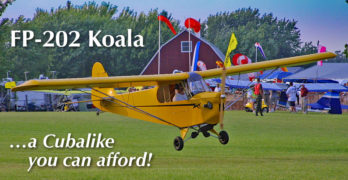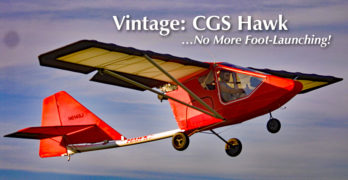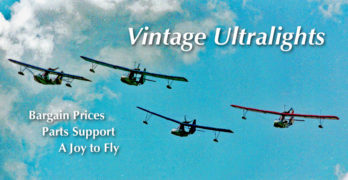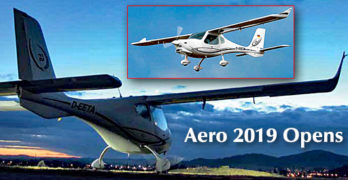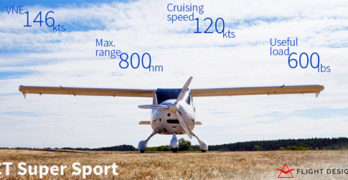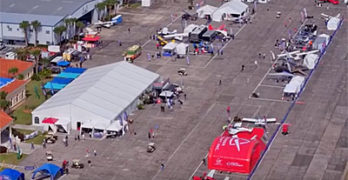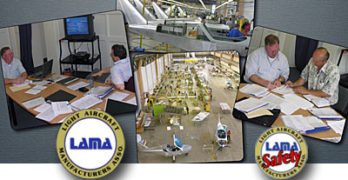The first time I ever saw Lazair fly — a fly-in at the Tullahoma Airport, as I recall — a then-young Peter Corley flew the lightweight aircraft as though he was the pilot of a military fighter of the day. He pushed the sleek machine with the whining engines as he looped and rolled the machine with such apparent ease. At this early time of development for these aircraft, such maneuvers in what we called an ultralight were very unusual.
To say either Peter or Lazair was unusual proved something of an understatement. Lazair was, and remains, one of the most unorthodox aircraft of any kind. Several reasons stand out to define its uniqueness.
These differences included: an inverted-V tail, said to be the most efficient tail planform; twin engines (the tiniest ones imaginable); an aluminum structure not based solely on round tubing; and see-through wing and tail coverings. All that is just the overview.
Search Results for : series
Not finding exactly what you expected? Try our advanced search option.
Select a manufacturer to go straight to all our content about that manufacturer.
Select an aircraft model to go straight to all our content about that model.
Ultralight April 2020 — Fifth in the Vintage Series: Kolb Firestar
Amazingly enough, here in 2020, we have noticeably returned to our roots in very light aircraft. Almost 40 years after Mike Sacrey and his team at FAA created the still-incredible Part 103, one leading brand from those days is not only still in business and thriving, but they are largely building similar aircraft to four decades back.
The man you saw on the lead photo is the famed Dick Rahill, a one-man flying machine flying his machine at Sun ‘n Fun more capably than any robot. Over and over, Dick would blast off in the bright yellow Firestar that seemed attached to him. He’d make one quick pattern from the turf runway in Paradise City at Sun ‘n Fun only to land, jump right back in the takeoff line, and repeat. Launch, circle, land, repeat… over and over. It seemed like every other airplane taking off was Dick and his FireStar.
Ultralight April 2020 — Fourth in the Vintage Series: Hiperlight SNS 8 Biplane
As we continue with this fourth in a series of ten about very affordable light aircraft from earlier times, we stress again that all the aircraft presented in this series still have some essential qualities that warranted their inclusion.
First, these are all aircraft with which Videoman Dave and I are personally familiar. I have flown all but one on the list and I believe Dave has flown all of them. So, we come to the series with real experiences in these flying machines. It has been a while for many of them, but assuming maintenance is good (see the important message at the end), this can be reasonable for many pilots to consider. However, as with any used aircraft, the buyer must be aware. Neither Dave nor I can comment on any one particular aircraft.
Second, and with the maintenance message firmly planted in your mind, all the models in this Vintage Ultralight series still have parts available from current-day producers.
Ultralight April 2020 — Third in the Vintage Series: Fisher FP-202 Koala
When Fisher was still located where it began, in North Dakota, I paid a visit to the factory. It may have been the tidiest wood shop I have ever seen.
I had just written an article about kit-builder assembly manuals so I was keen to see examples of Fisher Flying Products full-size plans. That always sounded like a marketing term yet I knew it meant exactly what they called it.
Darlene Hansen showed me a neatly-organized series of boxes full of long tubes of paper. She took one out, for the fuselage of the Koala as it turned out (see nearby image). She went to one end of a long, flat table and briskly unfurled the tube of paper while hanging on to the loose edge. It rolled and rolled …and rolled, until a sheet about four feet wide and 20 feet long covered the work table.
You literally take the tiny wood pieces Fisher ships to you as part of the kit and lay them directly on the paper as shown.
Ultralight April 2020 — Second in the Vintage Series: CGS Hawk
Way back when, long before the birth of the Light-Sport Aircraft segment (in 2004), lots of us flew ultralights. They were barely more than powered hang gliders — except one.
Before 1982 these lightest-of-all aircraft were required to be foot-launchable. It’s true. I once staggered into the air partly carrying, partly dragging a Quicksilver. I got airborne thanks to a generous 15 mph headwind that provided about three quarters of the speed I needed for… um, you can’t call it “rotation,” but to get enough lift that I could sit down.
Yes, “sit down.” You didn’t think I ran for take off while sitting comfortably belted into a secure seat did you? Nope, that Quicksilver had a literal swing seat and a special rear axle that allowed a full stride of your legs.
OK, that requirement proved futile and FAA later dropped it, but one guy in particular drove that older requirement into the annals of history.
Ultralight April 2020 — First in the Vintage Series: Buccaneer XA
A frequent comment I hear is that the price of recreational aircraft are too high. Some pilots have been stating this for 18 years, since a couple years before Light-Sport Aircraft emerged.
Back in 2002, many believed that the new LSA-to-come would cost $50-60,000. Right or wrong (about those price guesstimates), that range today would be $72-87,000, after correcting for the decline in the dollar’s purchasing power. The truth is that you do have some new choices at that price point but for many, such a cost remains out of their budget for any recreational vehicle, airborne or otherwise.
To those pilots, I often suggest a good, used aircraft and we have more such LSA every year, many of which are excellent buys. Yet, how about we drop down the price further?
How About a Used
Part 103 Ultralight?
Long before LSA were introduced, I flew a single-place Buccaneer with a Rotax 377.
Aero Friedrichshafen Day 1 Aircraft Highlights: Zlin Ultra 915, Flight Design F-Series, Belmont
Jetting straight from Sun ‘n Fun, we were able to arrive at Aero Friedrichshafen by noon on opening day. A quick swing around the most light-aircraft-filled halls (the “B” halls) brought some fresh surprises. Following are a few designs that caught my eye on an initial pass.
The profusion of light aircraft we don’t see in the USA — some of which will never reach the market — is one of the main reasons Aero Friedrichshafen is my favorite show in Europe. This mostly indoor fair (as Europeans call such shows) always has many ideas of interest.
Zlin Ultra with Rotax 915iS — Never one to rest Pascale Russo reintroduced his Ultra Shock from last Aero with the more powerful Rotax 915iS. Ultra Shock plays on the term “ultralight,” which means something different in Europe than in the USA (it is a reference to light aircraft quite similar to Light-Sport Aircraft).
Twin Accomplishments for Flight Design and their CT series of Light-Sport Aircraft
As a new season of flying is upon us (even while northern pilots may still be still shoveling snow), one company continues their vigorous comeback. Flight Design announced completion of a new product and is offering a second. Based on the same CT-based airframe, the two are notably different.
CT Super Sport Injection
The German developer of the CT series is now planning to offer the CT Super Sport Injection in North America. CT Super Sport is the popular model sold in Europe with a cruising speed of 120 knots, VNE of 146 knots, useful load of more than 600 pounds (272 kilograms), and an affordable price.
“This variation will now be reintroduced to the Americas,” reported Tom Peghiny, President of Flight Design USA. “We have sold versions of the CTLS since its introduction in 2008 and wanted to bring back a lighter model primarily for the U.S.
Parting Views of Sebring 2018 — Our Popular “Race Around” Video Series
We started a few shows back doing a drive-by shooting (except in a good way). In this effort, we pair up on a golf cart with Videoman Dave running the camera and yours truly trying my best to keep up and not flub my lines.
All this is extemporaneous (a fancy word for un-scripted) so if I stumble now and again with an airplane fact, please pardon the error. We like to knock these out and that doesn’t allow for retakes. I think I got most of it right or at least Dave managed to edit out any disqualifying errors I may have made.
According to new Sebring Expo Program Manager, Janice Rearick, we have a few facts to pass along from Sebring 2018.
More than 100 exhibitors displayed their wares. As mentioned in our earlier report, a good number of aircraft were sold and Janice indicated, “Several vendors we surveyed waved long sheets of leads collected at the show.” When vendors succeed, we pilots get more and better aircraft choices with better service from healthier companies.
Politics and LSA… 1st in a Series: Certification
In a series of posts from time to time, I will explore the relationship between government(s) and aviation. I plan to take a global view but the essence is this: Since the beginning of aviation (or at least since near the beginning) government has approved any aircraft the public may buy and fly. A newly designed model, after proving its airworthiness to company engineers and management, had to gain government approval before sales could begin. *** The cost curve has been steeply upward. Cirrus Design is a company whose emergence I watched very closely when I worked for BRS parachutes some years ago. We were deeply involved with Cirrus in the certification of a parachute system for the SR20. My front-row seat gave an intimate look into the approval process. Cirrus reported a cost of many tens of millions of dollars to get a Part 23 Type and Production Certificate. *** Then came LSA.
- « Previous Page
- 1
- 2
- 3
- 4
- …
- 65
- Next Page »


